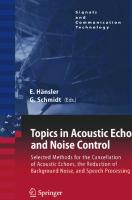Radio Wave Propagation in Vehicular Environments 1785618237, 9781785618239
Providing a unified treatment of radio wave propagation in vehicular environments, this book offers a thorough discussio
325 75 2MB
English Pages 386 [382] Year 2021
Table of contents :
Contents
About the authors
Acknowledgments
Acronyms
Notation
1. Introduction to vehicular communications
1.1 Intelligent transportation systems
1.2 Vehicular communication environments
1.3 Vehicular networking
1.4 Standards and current technologies
References
2. Wireless channel properties for vehicular environments
2.1 Wideband vs. narrowband channels
2.2 Fundamentals of propagation in wireless channels
2.3 Vehicular channels for V2X communications
2.4 Single and multi-antenna communications
References
3. Modelling and simulation of vehicular communications
3.1 Channel-specific properties for vehicular communications
3.2 Modelling approaches
References
4. Intra-vehicle short-range wireless channel characterization
4.1 Intra-vehicle scenarios radio wave propagation analysis
4.2 Case studies for intra-vehicle electromagnetic properties in ITS
4.3 Intra-vehicle radio planning analysis
References
5. Inter-vehicle short-range wireless channel characterization
5.1 Inter-vehicle scenarios radio wave propagation analysis
5.2 Case studies for inter-vehicle electromagnetic properties in ITS
5.3 Inter-vehicle radio planning analysis
References
6. Vehicular communications channel modelling
6.1 Channel modelling, measurement and estimation
6.2 Radio channel measurements
6.3 Vehicular channel characterization
6.4 V2X channel models
6.5 Channel prediction and estimation
6.6 Channel model selection
References
7. Wireless communication system optimization
7.1 Radio planning for vehicular environments
7.2 Coverage/capacity inter-vehicular analysis
7.3 Coverage/capacity intra-vehicular analysis
7.4 Considerations for inter-system operation
References
8. Applications and case studies
8.1 Location and tracking
8.2 Tunnels
8.3 Autonomous vehicles
8.4 Intelligent transportation systems
8.5 UAV systems
8.6 Terrain and vegetation
8.7 Roundabouts
8.8 Safety and security applications
8.9 Evolution within future 5G scenarios
8.10 Economic impact of vehicular communication technology
References
Index
Contents
About the authors
Acknowledgments
Acronyms
Notation
1. Introduction to vehicular communications
1.1 Intelligent transportation systems
1.2 Vehicular communication environments
1.3 Vehicular networking
1.4 Standards and current technologies
References
2. Wireless channel properties for vehicular environments
2.1 Wideband vs. narrowband channels
2.2 Fundamentals of propagation in wireless channels
2.3 Vehicular channels for V2X communications
2.4 Single and multi-antenna communications
References
3. Modelling and simulation of vehicular communications
3.1 Channel-specific properties for vehicular communications
3.2 Modelling approaches
References
4. Intra-vehicle short-range wireless channel characterization
4.1 Intra-vehicle scenarios radio wave propagation analysis
4.2 Case studies for intra-vehicle electromagnetic properties in ITS
4.3 Intra-vehicle radio planning analysis
References
5. Inter-vehicle short-range wireless channel characterization
5.1 Inter-vehicle scenarios radio wave propagation analysis
5.2 Case studies for inter-vehicle electromagnetic properties in ITS
5.3 Inter-vehicle radio planning analysis
References
6. Vehicular communications channel modelling
6.1 Channel modelling, measurement and estimation
6.2 Radio channel measurements
6.3 Vehicular channel characterization
6.4 V2X channel models
6.5 Channel prediction and estimation
6.6 Channel model selection
References
7. Wireless communication system optimization
7.1 Radio planning for vehicular environments
7.2 Coverage/capacity inter-vehicular analysis
7.3 Coverage/capacity intra-vehicular analysis
7.4 Considerations for inter-system operation
References
8. Applications and case studies
8.1 Location and tracking
8.2 Tunnels
8.3 Autonomous vehicles
8.4 Intelligent transportation systems
8.5 UAV systems
8.6 Terrain and vegetation
8.7 Roundabouts
8.8 Safety and security applications
8.9 Evolution within future 5G scenarios
8.10 Economic impact of vehicular communication technology
References
Index

- Author / Uploaded
- Leyre Azpilicueta
- Cesar Vargas-Rosales
- Francisco Falcone
- Ana Alejos
- Similar Topics
- Technique
- Electronics: Radio



![Essentials of Radio Wave Propagation [1 ed.]
052187565X, 9780521875653, 9780511371127](https://ebin.pub/img/200x200/essentials-of-radio-wave-propagation-1nbsped-052187565x-9780521875653-9780511371127.jpg)



![Radio wave propagation an introduction for the non-specialist [1 ed.]
3540771247, 9783540771241](https://ebin.pub/img/200x200/radio-wave-propagation-an-introduction-for-the-non-specialist-1nbsped-3540771247-9783540771241.jpg)

